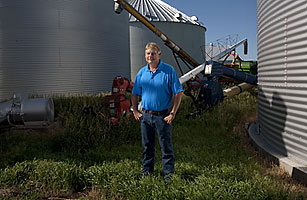
If you want to become rich, Jim Rogers, investment whiz, best-selling author and one of Wall Street’s towering personalities, has this advice: Become a farmer. Food prices have been high recently. Some have questioned how long that can continue. Not Rogers. He predicts that farming incomes will rise dramatically in the next few decades, faster than those in most other industries — even Wall Street. The essence of his argument is this: We don’t need more bankers. What we need are more farmers. The invisible hand will do its magic. “The world has got a serious food problem,” says Rogers. “The only real way to solve it is to draw more people back to agriculture.” It’s been decades since the American heartland has been a money pump and longer since farming was a major source of employment. Old rural towns have emptied as families — and the U.S. — have moved on. Technology, service jobs and finance have been the basis of the economy since at least the 1980s. Farming became the economic equivalent of a protected species — supported by a mix of government handouts, lax regulation and charity concerts.
But in the past few years, thanks to a wealthier emerging-market middle class and a boom in biofuels, the business of growing has once again become a growth business. At a time when the overall economy is limping along at an anemic growth rate of 1.9%, net farm income was up 27% last year and is expected to jump another 20% in 2011. Real estate prices in general are again falling this year. But according to the Federal Reserve, the average farm has doubled in value in the past six years. Farmland is quickly emerging as one of the year’s hottest investments on Wall Street. “We’ve been doing this for a number of years, long before anyone thought this was sexy,” says Jeff Conrad, who heads Hancock Agricultural Investment Group. “Now we are getting a lot of calls, and we are noticing more competition. There’s a lot of interest in New York.” These days, a trip to Grand Island, Neb., a city of 48,500 surrounded by farms, is a trip to an economic bizarro land. Business is booming. None of the half-dozen or so local banks in town have failed or even come close to failing. In fact, profits are up. “A lot of local banks are sitting with a lot of cash,” says Colby Collins, Grand Island branch manager for Five Points Bank. The largest local manufacturing plant, which makes combine harvesters, is at full capacity. Case IH plant manager Bill Baasch has hired 130 workers in the past nine months. Sales at Global Industries, a company based in Grand Island that makes grain-storage bins and other building materials, are up 130% since 2003. Tom Dinsdale, who owns the local General Motors car dealership, says 2010 was the best year he’s ever had. Customers who would normally buy a Chevy Suburban are buying a Cadillac Escalade. Dinsdale is adding an infinity pool to his nearby riverfront second home. “Business is good,” he says.Even housing has done well in the past few years. Realtor Lisa Crumrine says her office has sold 48 homes in Grand Island in 2011 and that prices are up slightly. Greg Baxter, a cattle rancher and real estate developer, says he has sold six lots so far this year in a development just off Grand Island’s commercial strip. Local homebuilders are busy constructing custom homes on the properties. That’s one reason Nebraska’s unemployment rate is 4.1%, the second lowest in the country behind that of mining-heavy North Dakota. Iowa’s unemployment rate is a slightly higher 6%, still far lower than California’s 11.7%, New York’s 7.9% or the national average of 9.1%.